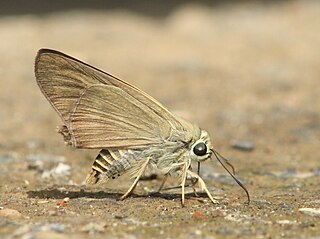
Badamia exclamationis, commonly known as the brown awl or narrow-winged awl, is a butterfly belonging to the family Hesperiidae. It is found in south and southeast Asia, Australia, and Oceania.

Bibasis gomata, commonly known as the pale green awlet, is a butterfly belonging to the family Hesperiidae. It is found in Northeast India, the Western Ghats and parts of Southeast Asia. The butterfly was reassigned to genus Burara by Vane-Wright and de Jong (2003) and is considered by them to be Burara gomata.

Burara jaina, the orange awlet, is a species of hesperid butterfly found in Asia. The butterfly was reassigned to the genus Burara by Vane-Wright and de Jong (2003), and is considered Burara jaina by them.

Hasora badra, the common awl, is a butterfly belonging to the family Hesperiidae, which is found in India.

Ampittia dioscorides, the common bush hopper or simply bush hopper, is a species of butterfly found in India, China, Indochina, Cambodia and on to Borneo, Sumatra and Java belonging to the family Hesperiidae.

Gangara thyrsis, commonly known as the giant redeye, is a species of butterfly belonging to the family Hesperiidae. It breeds on a number of palm species.

Matapa aria, the common redeye, is a species of butterfly belonging to the family Hesperiidae. It is found in India and Southeast Asia.
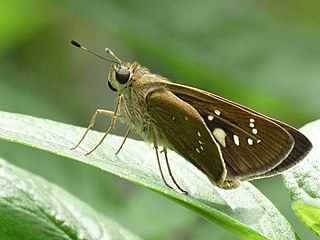
Pelopidas subochracea, the large branded swift, is a butterfly belonging to the family Hesperiidae found in India.
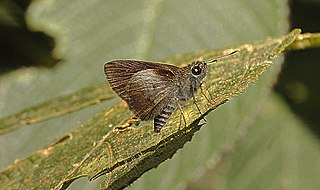
Suastus minuta, the small palm bob, is a butterfly belonging to the family Hesperiidae. It is found in the Indomalayan realm - south India, Sikkim to Burma, Sri Lanka, Thailand, Laos, Hainan, Vietnam and Malaya.
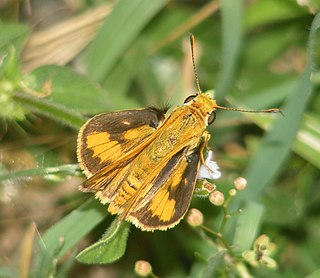
Telicota colon, commonly known as the pale palm dart or common palm dart, is a species of butterfly in the family Hesperiidae. It is found from India to Australia.

Thoressa sitala, the Tamil ace or Sitala ace, is a butterfly belonging to the family Hesperiidae found in south India.<

Abaratha ransonnetii, commonly known as the golden angle, is a butterfly belonging to the family Hesperiidae. It was first described by Baron Cajetan von Felder in 1868.
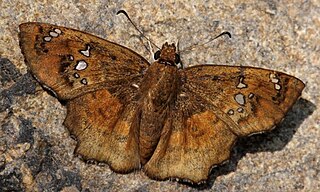
Abaratha agama, the spotted angle, is a species of butterfly belonging to the family Hesperiidae. It is found from southern India to Myanmar and in Thailand, Laos, Vietnam, southern China, Java and Sulawesi. The species was first described by Frederic Moore in 1857.
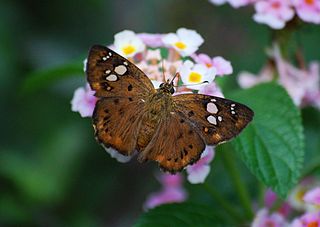
Coladenia indrani, the tricolour pied flat, is a butterfly belonging to the family Hesperiidae found in Sri Lanka, India to Myanmar. The species was first described by Frederic Moore in 1865.

Hyarotis microstictum, the brush flitter, is a butterfly belonging to the family Hesperiidae. It is found in the Indomalayan realm and in South India. H. m. coorga Evans, 1949 is the subspecies found in South India. H. m. microstictum is the subspecies found in the Indomalayan realm.

Appias indra, the plain puffin, is a small butterfly of the family Pieridae, that is, the yellows and whites, which is found in south and southeast Asia.

Appias libythea, the striped albatross, is a small butterfly of the family Pieridae, that is, the yellows and whites, which is found in south and southeast Asia.

Horaga onyx, the common onyx, is a species of lycaenid or blue butterfly found in the Indomalayan realm.

Bibasis harisa, the orange awlet, is a species of hesperid found in Asia. The butterfly was reassigned to genus Burara by Vane-Wright and de Jong (2003) and is considered by them to be Burara harisa.

Telicota bambusae, the dark palm dart, is a species of grass skipper butterfly in the family Hesperiidae. It is found in India, Sri Lanka and on Peninsular Malaysia.




















